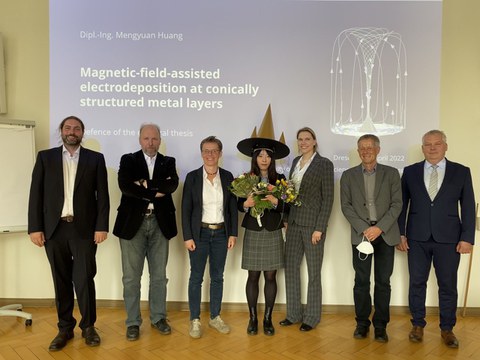Apr 28, 2022
Congratulations to Mengyuan Huang on her successful PhD defence
Micro- and nano-sized conical structures possess specific magnetic, superhydrophobic
and electrocatalytic properties and are therefore attractive for numerous applications.
Among the various methods of manufacturing such structured layers, electrodeposition
appears a simple and inexpensive method. Beside the use of capping agents, the applica-
tion of magnetic fields could support the local growth of cones on a non-templated planar
electrode.
This dissertation investigates electrodeposition at conically structured metal layers in ex-
ternal magnetic fields. Depending on the direction and the intensity of the magnetic field,
the Lorentz force and the magnetic gradient force can generate electrolyte flow and bring
electrolyte enriched with metal ions towards the cone tips. As a result, the local deposition
rate is increased and conical growth is promoted. In order to obtain a basic understand-
ing of the magnetic field effects, systematic numerical and theoretical investigations are
performed for electrodeposition at mm-sized cones of different materials, shapes and ar-
rangements under different electrochemical and magnetic conditions. If a uniform external magnetic field is oriented parallel to the cone axis, the magnetic gradient force enabled by the magnetization of ferromagnetic cones provides a strong support for conical growth, thereby often dominating over the Lorentz force and the buoyancy force arising from electrode reactions. This supporting effect is only slightly mitigated when neighboring cones are getting closer. The numerical results shown are validated by experimental data for different configurations and deposition parameters.
In order to explore the prospects of magnetic fields to enhance the growth of smaller, μm
and nm sized conical structures, scaling laws of the local flows driven by the magnetic forces are derived numerically and confirmed analytically for shrinking cone sizes. Although the magnetic gradient force can generate a beneficial flow at ferromagnetic cones, the small flow region and the nearly constant thickness of the concentration boundary layer limit the support of the magnetic field. Enhancements of the structuring effect are observed for pulsed deposition and, despite only moderately, at higher magnetic field intensities. Furthermore, a simplified modeling approach is developed to simulate the growth mechanism of nano-cones with respect to the influence of capping agents.
Experimental results of the electrodeposition of Ni cones in magnetic fields obtained by partners in Krakow are analyzed by performing simulations of both the global cell flow and the local flows generated by magnetic fields of different orientations. This two-step approach provides an interpretation of the experimental results, and gives a deeper insight on how the capping agent influences the local growth.
Finally, the impact of the hydrogen side reaction on the electrodeposition in magnetic fields is considered. The numerical results indicate that hydrogen bubbles sitting at the cone tips may damp conical growth, while the magnetic-field-driven flow imposes a weak stabilizing force on the bubble.

